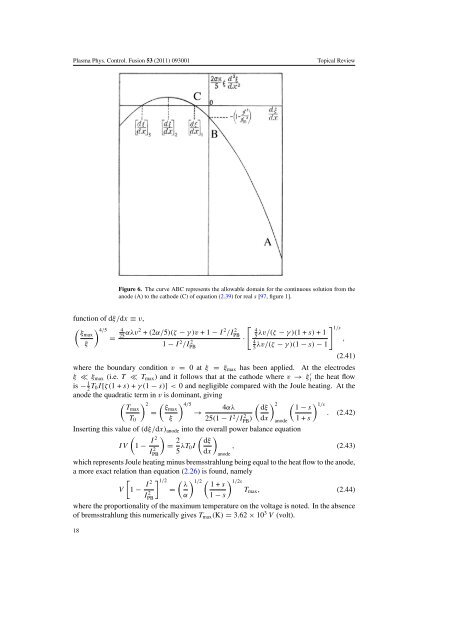Create successful ePaper yourself
Turn your PDF publications into a flip-book with our unique Google optimized e-Paper software.
Plasma Phys. Control. Fusion 53 (2011) 093001<br />
Topical Review<br />
Figure 6. The curve ABC represents <strong>the</strong> allowable domain for <strong>the</strong> continuous solution from <strong>the</strong><br />
anode (A) to <strong>the</strong> cathode (C) <strong>of</strong> equation (2.39) for real s [97, figure 1].<br />
function <strong>of</strong> dξ/dx ≡ v,<br />
( ) [ ] 4/5 4<br />
ξmax<br />
25<br />
=<br />
αλv2 + (2α/5)(ζ − γ)v+1− I 2 /IPB<br />
2 4 1/s<br />
λv/(ζ − γ)(1+s) +1<br />
5<br />
ξ<br />
1 − I 2 /IPB<br />
2 ·<br />
4<br />
5 λv/(ζ − γ)(1 − s) − 1 ,<br />
(2.41)<br />
where <strong>the</strong> boundary condition v = 0atξ = ξ max has been applied. At <strong>the</strong> electrodes<br />
ξ ≪ ξ max (i.e. T ≪ T max ) and it follows that at <strong>the</strong> cathode where v → ξ<br />
1 ′ <strong>the</strong> heat flow<br />
is − 1 2 T 0I[ζ(1+s) + γ(1 − s)] < 0 and negligible compared with <strong>the</strong> Joule heating. At <strong>the</strong><br />
anode <strong>the</strong> quadratic term in v is dominant, giving<br />
( ) 2 ( ) 4/5 ( )<br />
Tmax ξmax<br />
4αλ dξ 2 ( ) 1 − s 1/s<br />
= →<br />
T 0 ξ 25(1 − I 2 /IPB 2 ) . (2.42)<br />
dx anode 1+s<br />
Inserting this value <strong>of</strong> (dξ/dx) anode into <strong>the</strong> overall power balance equation<br />
IV<br />
(1 − I 2 )<br />
= 2 ( ) dξ<br />
5 λT 0I<br />
dx<br />
IPB<br />
2 , (2.43)<br />
anode<br />
which represents Joule heating minus bremsstrahlung being equal to <strong>the</strong> heat flow to <strong>the</strong> anode,<br />
a more exact relation than equation (2.26) is found, namely<br />
V<br />
[1 − I 2 ] 1/2 ( ) λ 1/2 ( ) 1+s 1/2s<br />
=<br />
T max , (2.44)<br />
α 1 − s<br />
I 2 PB<br />
where <strong>the</strong> proportionality <strong>of</strong> <strong>the</strong> maximum temperature on <strong>the</strong> voltage is noted. In <strong>the</strong> absence<br />
<strong>of</strong> bremsstrahlung this numerically gives T max (K) = 3.62 × 10 3 V (volt).<br />
18














